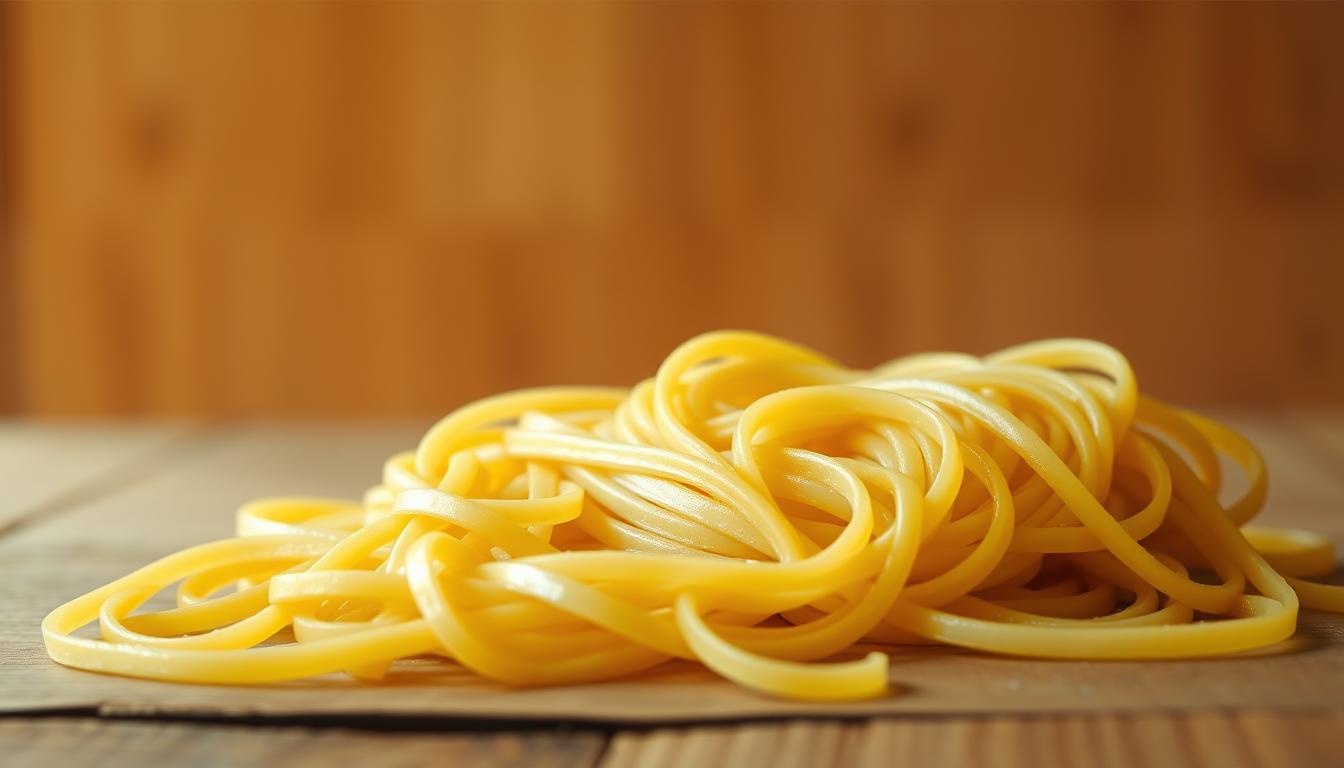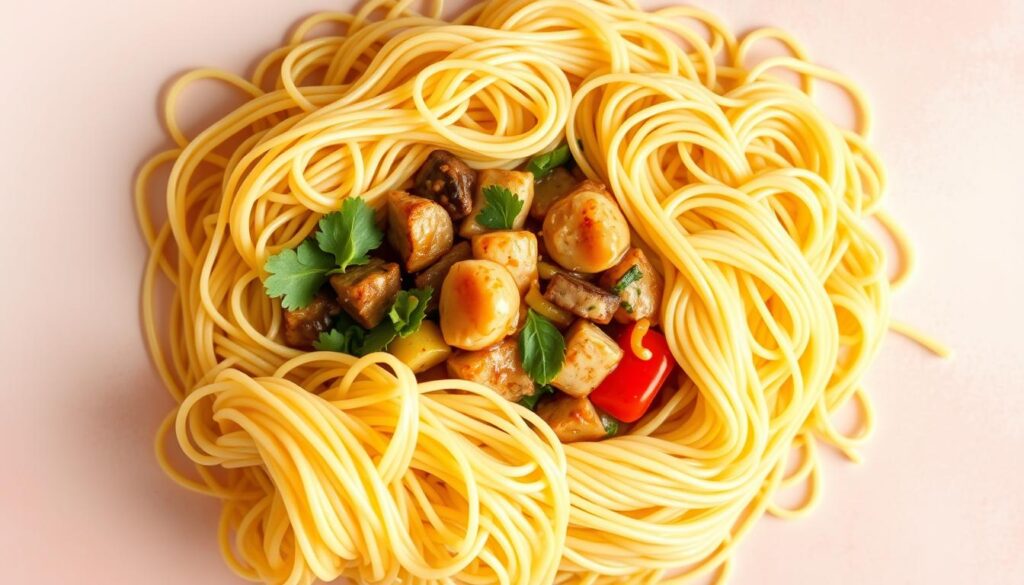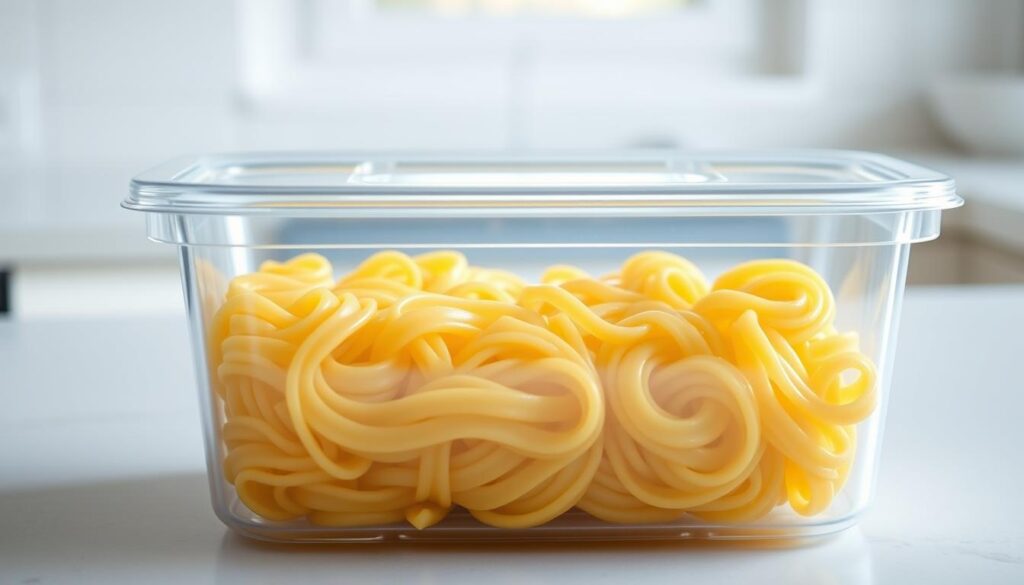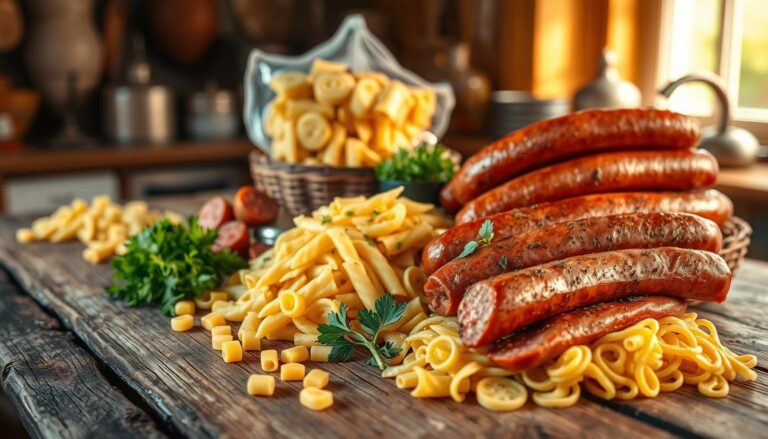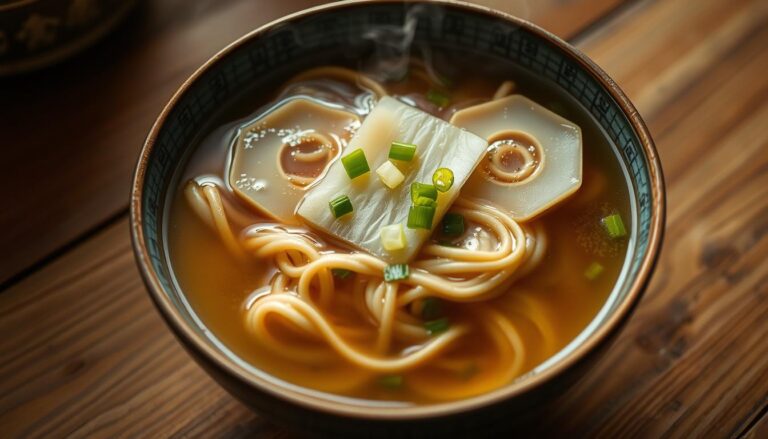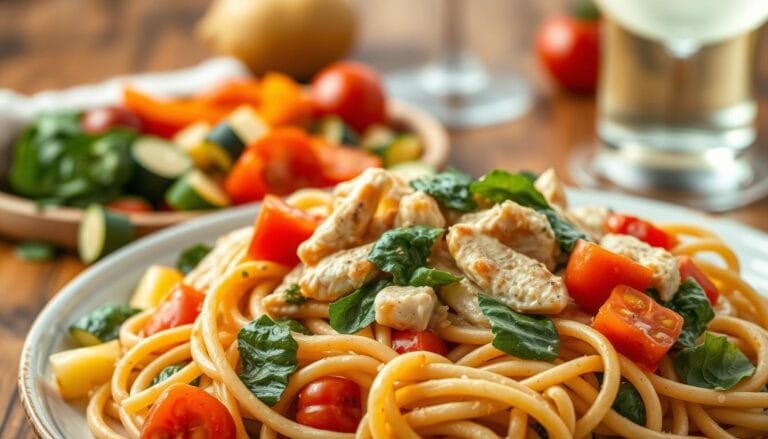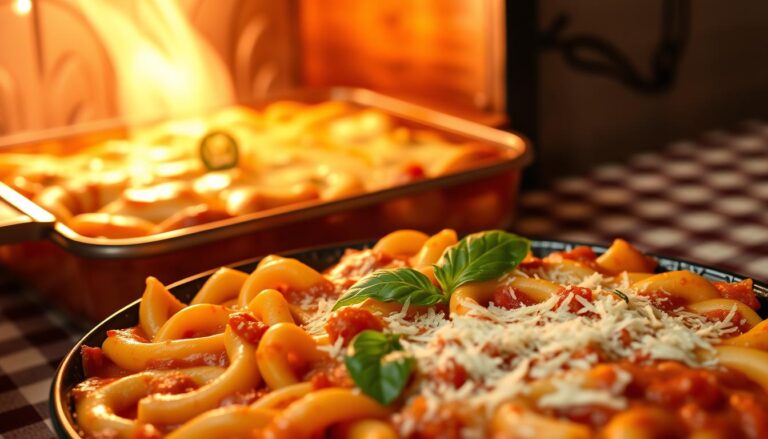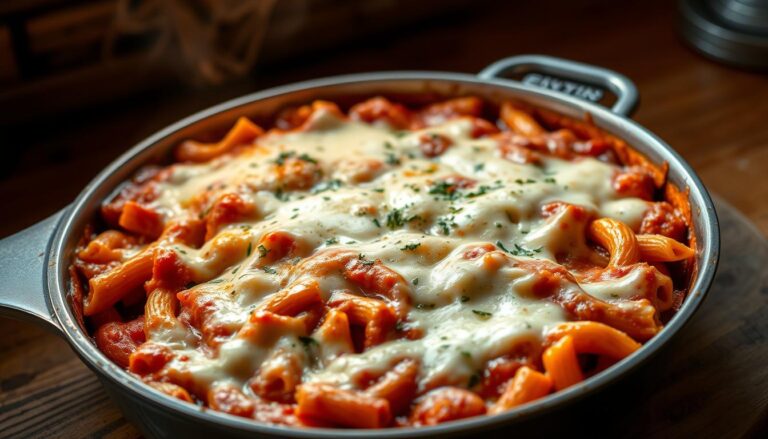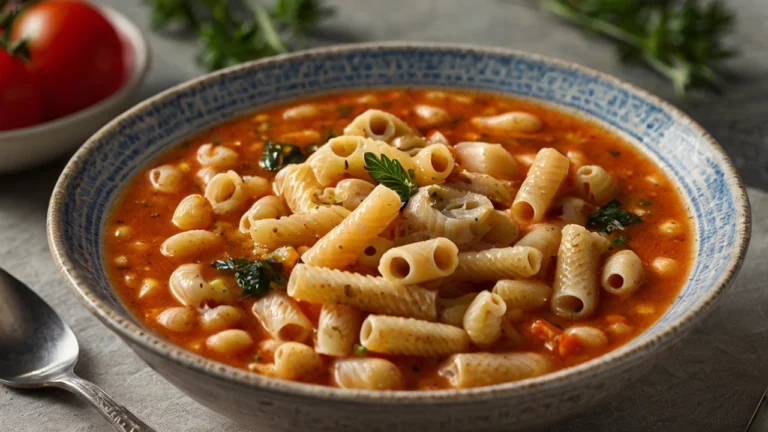Delicious Wide Egg Noodles – Perfectly Cooked
Table of Contents
There’s something comforting about the golden strands of perfectly cooked wide egg noodles. They cling to sauces, hold their shape, and become the star of any dish. But when they’re undercooked or mushy, the dish feels off. This leaves you wondering if you’re doing something wrong in the kitchen.
Whether you’re making a cozy family dinner or a weekend treat, getting it right is important. It’s all about the details.
Key Takeaways
- Wide egg noodles offer unmatched texture and versatility for dishes from soups to stir-fries.
- Mastering cooking techniques ensures they stay tender yet firm, not sticky or bland.
- Properly cooked egg noodles can elevate comfort foods and gourmet meals alike.
- Understanding their unique traits helps pair them with sauces and flavors perfectly.
- Small adjustments like water ratios and cooking times make all the difference.
What Are Wide Egg Noodles?
Wide egg noodles are a type of pasta that’s becoming more popular. They have a rich flavor and a unique texture. Unlike regular noodles, these egg-enriched varieties stand out in three key ways.
The Defining Characteristics of Egg Noodles
These noodles have more egg than regular pasta. This gives them a golden color and a buttery taste. They are also firmer and less starchy. Look for packages labeled “egg noodles” with at least 20% egg content for the authentic experience.
Different Width Options Available
- Medium: 1/4-inch thick, ideal for light sauces like broth-based soups
- Wide: 3/8-inch thickness, pairs well with chunky meat sauces
- Extra-wide: Over 1/2-inch, perfect for holding heavy cream or cheese-based toppings
How They Differ From Other Pasta Types
Compared to spaghetti or fettuccine, wide egg noodles have:
- Higher protein content from eggs
- Less gluten development for softer mouthfeel
- Unique rectangular shape vs. rounded edges on most noodles
These differences mean they cook faster than eggless pasta. They also need specific sauce pairings to shine. Choose the width based on your dish’s texture needs—thicker noodles work best with hearty toppings.
The Rich History of Egg Noodles
Egg noodles have traveled far beyond ancient China, becoming a global favorite. They started over 2,000 years ago on the Silk Road. Traders carried dried egg noodles across continents.
By the Middle Ages, explorers like Marco Polo introduced them to Italy and Germany. There, they became local favorites.
- China: Lamian, hand-pulled egg noodles still served in traditional markets
- Germany: Spätzle, soft egg noodles popular in Bavarian cuisine
- Jewish Communities: Lokshen, thin egg noodles used in classic chicken soup
| Culture | Traditional Dish | Key Feature |
|---|---|---|
| China | Lamian | Hand-stretched with wheat and eggs |
| Germany | Spätzle | Rough texture from dough scraps |
| Jewish | Lokshen | Crispy when baked in kugel desserts |
European immigrants brought egg noodles to America in the 19th century. They became a comfort food, like in chicken noodle casserole. These noodles show how cultures share traditions.
Your great-grandparents might have cooked them like those in 18th-century Poland or Ming Dynasty China. Today, egg noodles connect us to our cooking heritage.
Nutritional Benefits of Wide Egg Noodles
Learning about wide egg noodles’ nutrition helps you choose better. They have more protein from eggs but differ in calories from other pasta. Here’s what you need to know.
Calorie and Macronutrient Breakdown
A 100-gram serving of wide egg noodles has about 360 calories. It also has 13 grams of protein and 68 grams of carbs. The eggs add more protein than regular pasta, which has about 10g per serving. To keep calories in check, control your portion size.
Comparing Egg Noodles to Other Pasta
- Regular wheat pasta: Similar calories but 2–3g less protein
- Whole grain pasta: 10–20% fewer calories, more fiber
- Gluten-free pasta: Often higher carbs and fat, depending on ingredients
Making Healthier Choices With Egg Noodles
Pair wide egg noodles with veggies like spinach or broccoli for more fiber and vitamins. Choose brands that use 100% durum wheat for better protein. Try swapping ½ of your portion with zucchini noodles to reduce carbs. Cooking them al dente also lowers their glycemic impact.
Essential Tips for Cooking Perfect Wide Egg Noodles
Mastering the art of cooking wide egg noodles starts with precision. Follow these steps to achieve consistent texture and flavor every time.
Water-to-Noodle Ratio for Best Results
Use 4–6 quarts of water per pound of wide egg noodles. A larger pot prevents clumping, ensuring each strand cooks evenly. Too little water can cause overcrowding, leading to mushy results.
Salt and Other Additives in Cooking Water
Add 1–2 tablespoons of salt per gallon of boiling water. Salt enhances flavor absorption. Avoid oil—it doesn’t prevent sticking. Optional additions like garlic or bay leaves can boost depth of flavor.
Determining the Ideal Cooking Time
- Boil noodles 8–12 minutes depending on width: thicker noodles take longer.
- Adjust time at high altitudes where water boils at lower temps.
- Check packaging guidelines as a baseline.
Testing for Doneness
Test noodles by biting a piece. Wide egg noodles should be tender but firm at the center (al dente). Overcooked noodles lose their structure. Time-wise, start tasting 2–3 minutes before recommended time.
“The key to great pasta is respecting the bite. Undercook slightly—noodles continue cooking in sauce.” — Chef Marco Conti, pasta specialist
Common Mistakes to Avoid When Preparing Wide Egg Noodles
Cooking wide egg noodles right is all about avoiding simple mistakes. These errors can mess up the texture and taste. Knowing what to watch for can help fix these issues:
- Too Little Water: A small pot leads to sticky noodles. Use a big pot so noodles can swim in water.
- No Salt in Water: Without seasoning, noodles taste bland. Add 1-2 tablespoons of salt before adding noodles.
- Overcooking: Mushy noodles come from ignoring cooking times. Check for doneness 1-2 minutes early for the right texture.
- Skipping Stirring Early: Noodles stick together if not stirred in the first 2 minutes. Stir gently as soon as they’re in the pot.
- Rinsing After Cooking: Rinsing removes starches that help sauces stick. Drain well but don’t rinse unless it’s for a cold dish.
- Adding Noodles Prematurely: Cold or lukewarm water causes uneven cooking. Wait until water boils before adding noodles.
- Improper Cooling: Noodles keep moisture if left in wet colanders. Toss with oil before storing leftovers.
Avoiding these mistakes ensures your egg noodles stay perfect. They’ll pair well with any sauce. Always use the right techniques to bring out their best.
Delicious Recipes Featuring Wide Egg Noodles
Turn wide egg noodles into unforgettable meals with these recipes. They range from comfort food to gourmet dishes. Their tender texture and rich flavor make them perfect for any dish.
Classic Comfort Food Dishes
Rediscover homey staples like chicken noodle soup. It gets heartier with wide egg noodles in a broth of roasted veggies and thyme. For tuna noodle casserole, layer cooked noodles with tuna, celery, and creamy béchamel sauce. Bake until golden, then top with crispy onions.
International Cuisine Using Egg Noodles
- Hungarian paprikash: Sauté paprika-spiced chicken with onion, add sour cream, then toss with al dente noodles.
- Asian stir-fry: Toss noodles with soy sauce, sesame oil, broccoli, and shrimp for a quick wok-fired meal.
Quick Weeknight Dinner Ideas
Cook noodles in 10 minutes and pair with pantry staples. Try a 5-ingredient skillet dish: sauté garlic and cherry tomatoes, add cooked noodles, toss with olive oil, Parmesan, and red pepper flakes. Serve with a green salad.
Gourmet Preparations for Special Occasions
Elevate meals with premium ingredients. For truffle lovers: toss noodles with sautéed morels, shaved parmesan, and truffle oil. Garnish with microgreens for a fancy touch. A seafood option: pan-sear scallops over noodles in a white wine butter sauce.
Pro Tip
“Pair wide egg noodles with sauces that cling, like hearty ragus or creamy Alfredo for maximum flavor absorption.” – Food Network Chef
Whether crafting a cozy family meal or a dinner party centerpiece, these recipes prove wide egg noodles are a kitchen staple for any occasion.
How to Make Homemade Wide Egg Noodles From Scratch
Learn to make homemade egg noodles with this easy recipe. You’ll need 2 cups of all-purpose flour, 3 large eggs, and a pinch of salt. First, make a well in the flour and add the eggs. Mix until a dough forms.
| Ingredient | Quantity |
|---|---|
| All-purpose flour | 2 cups |
| Large eggs | 3 |
| Salt | ½ tsp |
- Knead the dough for 8-10 minutes until it’s smooth. Let it rest, covered, for 30 minutes.
- Roll the dough thinly, either with a pasta machine or a rolling pin, to 1/16-inch thickness.
- Use a sharp knife or pasta cutter to cut the dough into ½-inch strips. Toss with flour to prevent sticking.
- Is your dough too sticky? Add a bit more flour.
- Want to keep your noodles fresh longer? Dry them on a rack for 1 hour before cooking.
- Cook your egg noodles for 2-3 minutes in boiling water. They cook faster than dried pasta.
Pro tip: Add herbs like parsley or nutritional yeast to the dough for extra flavor. These homemade noodles soak up sauces better than store-bought ones. Store leftovers in an airtight container for up to 2 days or freeze for 2 months.
Pairing Your Wide Egg Noodles With Complementary Sauces
Wide egg noodles are perfect with sauces that match their thick texture and rich taste. Their rough surface holds onto sauces better than thin pastas. This makes them great for bold, creamy, or textured toppings.
Cream-Based Sauces That Work Well
Rich cream sauces bring out the best in egg noodles. Try these:
- Classic Alfredo: Mix with parmesan and butter for a velvety coating.
- Garlic Cream: Add sautéed garlic and herbs for depth.
- Four-Cheese Sauce: Blend cheddar, gouda, and gruyere for sharpness.
For a quick recipe, melt ½ cup heavy cream with 2 tablespoons butter and 1 cup shredded cheese in a saucepan.
Tomato Sauces and Variations
Tomato-based sauces complement egg noodles’ chewiness. Choose hearty options like:
- Bolognese with ground beef and red wine
- Chunky marinara with roasted garlic
- Spicy arrabbiata for a kick
Pro tip: Simmer tomato sauce longer to thicken its consistency for better adhesion.
Asian-Inspired Sauce Pairings
Try these bold flavor combinations:
| Sauce Type | Example | Pairing Tip |
|---|---|---|
| Creamy | Alfredo | Add a dash of truffle oil |
| Tomato | Bolognese | Stir in a splash of cream for balance |
| Asian | Sesame-ginger | Top with scallions and sesame seeds |
For an Asian-inspired dish, toss cooked noodles with a sauce made from soy sauce, sesame oil, and honey. Add shredded chicken for protein.
Storing and Preserving Your Egg Noodles
Keeping egg noodles fresh is key. Follow these steps to keep them tasty and ready to use, whether they’re dried or cooked.
Storing dried pasta right can make it last longer. For cooked noodles, here’s what to do:
Refrigeration Guidelines
After cooking, mix egg noodles with a bit of oil to stop them from sticking. Put them in an airtight container in the fridge for up to 5 days. If they smell bad or feel slimy, throw them away.
Freezing Techniques
To freeze cooked noodles, lay them flat on a baking sheet first. Then, put them in freezer bags. Dried noodles can be frozen in their original packaging for up to 6 months. Use freezer-safe containers and mark them with the date.
| Storage Method | Optimal Time | Best Practices |
|---|---|---|
| Refrigeration | 3–5 days | Use airtight containers with oil coating |
| Freezing | 2–3 months | Flash freeze before packing to prevent clumping |
Reheating Methods That Maintain Texture
- Microwave: Add a splash of water and cover with a damp cloth.
- Stovetop: Simmer in broth or water until heated through.
- Oven: Toss with sauce and bake at 350°F for 15 minutes.
Always check the texture—don’t overcook reheated pasta. Adjust the method based on your dish.
Gluten-Free and Alternative Wide Egg Noodle Options
Not everyone can enjoy traditional wide egg noodles. But you don’t need to miss out. Many brands now offer gluten-free versions. They use ingredients like rice flour and tapioca starch.
Look for options from brands such as Jovial, Tinkyada, or King Arthur. These brands make noodles that feel like regular noodles but without wheat.
- Gluten-Free Options: Check labels for certified gluten-free ingredients. These noodles cook similarly but may need 1-2 minutes less to avoid sogginess.
- Egg-Free Noodles: Vegan-friendly varieties use potato starch or chickpea flour. Brands like Explore Asia offer egg-free wide egg noodles for plant-based diets.
- Low-Carb Alternatives: Try shirataki noodles made from konjac root. They’re nearly calorie-free but require thorough rinsing to remove their fishy odor.
- Whole Grain Noodles: Brands like Lundberg use quinoa or brown rice flours. These add fiber but may need extra cooking time.
Always adjust cooking times. Some gluten-free noodles overcook faster. For homemade versions, mix almond flour, eggs, and xanthan gum to form dough.
Roll thinly and air-dry before boiling. Experimenting with these options lets you enjoy wide egg noodles while meeting dietary needs.
Creative Ways to Transform Leftover Wide Egg Noodles
Don’t throw away leftover egg noodles. Turn them into new dishes with these creative recipes. Each idea makes them taste fresh and delicious.
- Frittata Pancakes: Mix cooled noodles with eggs, diced veggies, and cheese. Shape into patties and bake until golden. Perfect for brunch or dinner.
- Crispy Noodle Nests: Toss noodles with olive oil and bake until crispy. Use as a crunchy base for salads, pizza, or as a topping.
- Asian-Style Salad: Combine noodles with carrots, cucumber, and a tangy dressing of soy sauce, lime juice, and sesame oil.
- Noodle Fritters: Pulse noodles in a food processor, then mix with flour and spices. Fry into crispy rounds. Serve with sriracha mayo.
- Baked Cheesy Cups: Layer noodles, tomato sauce, cheese, and herbs in muffin tins. Bake until bubbly for snacks.
Pro tips: moisture matters. For frittatas, drain noodles well. Add an egg or mayonnaise to bind. Try bold seasonings like garlic powder or chili flakes. Leftovers can also make soups heartier. With these tips, your egg noodles will be the main attraction in many meals.
Conclusion: Elevating Your Meals
Wide egg noodles are a timeless choice for making meals memorable. They work well in comfort food classics or with bold sauces. Learning how to cook them right, like using the right water ratio, makes them perfect every time.
These noodles are rooted in global traditions but fit modern tastes well. Try them with creamy sauces, tomato-based dishes, or Asian broths. Even leftovers can become exciting with a little creativity. For those who can’t have gluten, there are gluten-free options that still taste great.
Knowing how to cook wide egg noodles opens up a world of possibilities. You can make new versions of family recipes or come up with your own. Share your creations online or at parties. This ingredient has a long history, but your next dish could be a new chapter.
More Pasta Recipes More Egg Noodles Recipe
FAQ
How do I cook wide egg noodles correctly?
What dishes can I make with wide egg noodles?
Can I make homemade wide egg noodles?
How should I store my leftover cooked wide egg noodles?
Are there gluten-free alternatives to wide egg noodles?
What are the nutritional benefits of wide egg noodles?
What are common mistakes to avoid when preparing wide egg noodles?
There are no reviews yet. Be the first one to write one.

